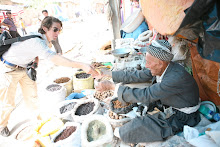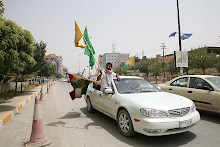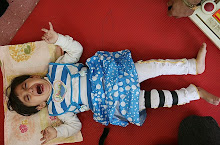Children’s centre for incurable diseases, torture cells, rap palace and Bach recital. It has been quite a day, and one which again has shown me the resilience and kindness of the Kurds, but also the dark side of this country.
Despite our troubles yesterday, today ran smoothly. This morning, we were met as promised by Rizghar, our rather quiet translator, and our driver (who bizarrely has spent time in Banbury, Oxfordshire), they will both be with us all week. We are lucky because Rizghar has been subcontracted from outside the PUK, therefore does not mind talking openly about politics and issues that plague this country. When someone talks for a minute though he translates for 15 seconds. I will be keeping my eye on him.
(p.s - Looking back at this, Rizghar has turned out to be wonderful. A great person, who I hope to work with again)
The Children’s centre this morning was the first harrowing event of the day, and brought to focus many things that are missing here. I have been wary of disabled children ever since being attacked by one at a French monastery as a child, so this, I was nervous about.
It is the only centre in Iraq that helps spastic children (their terminology), autism, cerebral palsy, polio victims and many other horrors. I wish I could accurately describe how far behind they are in understanding these diseases but the list is too long. They have blacksmiths, carpenters and leather smiths making toilets, wheelchairs, casts and special shoes for the children, on site. They literally hammer metal into shape for the children to wear and sow shoes by hand using pieces they can scrounge. They get no support from the central government, or from the red cross who have ignored their letters. They can barely afford to stay open and at one point while talking to the director (who doubles up as a paediatrician a cleaner and a nurse) there was a power cut. He didn't even skip a beat and just kept talking until the lights came on again – a regular occurrence throughout the country.
The centre has 15 – 20 staff who take care of 7/8000 patients around the country. They have 19000 on record. The problem is that the wider community does not fully understand these diseases and they are considered taboos. The saddest thing is that these children laugh, they play, they want affection but are treated as outcasts. I cannot really say any more as I do not know where to begin. It was not easy being there.
Next we visited the Amnasuraka security building – Saddam’s regional torture facility. The building itself, a grim communist style square is in ruins; pot marked by bullets from the outside and blackened on the in. When it was finally overthrown and everyone inside had been kicked or stamped to death there was still such anger among the people that they took it out on the building. When in use nobody would walk near it for fear both of random cruelty and to avoid the screams. Next door the torture chambers survived and have been left as they were. Blood marks the floors everywhere; the weapons used for torture are still there. Glass bottles for insertion, nails for driving into skulls, metal rods, electricity – the list is limited only by imagination.
For every person found guilty of being a peshmerga the whole family was raped and killed, their house bulldozed, and anyone left alive forced to pay for the bullets. The centre has life-sized sculptures recreating the horrors. Usually recordings of genuine torture are played at full volume (courtesy of Saddam’s extensiv archives) but today, thank God, the system was broken.
Our driver, our translator and our guide had all lost family members there – they were in tears. While interviewing someone about the chemical atrocities my battery ran out. I didn’t have it in me to ask him to stop and just held the camera till he finished. In a weird way it felt like that scene from true lies. I have been to Auschwitz, I have been to Rwanda, I have been to S.E Asia, I have seen or heard little like this.
After more meat, rice and beans we drove outside the city to meet up with our budding rap artists. This centre is for any and all forms of music and dance. The diversity was amazing. From traditional Kurdish music (we met the classical finalist of Iraqi idol) to western stlye rappers, Persian rappers, flamenco guitarists, Bach pianists and break dancers. There was of course a varying degree of talent among them, but I thought it wise not to tell Iraqi gangsta rappers they didn’t have it in them. Some of them however are the funniest little people I have met; bandanas, bling and bass. “Feeefty sense big idol”
What I saw here was a microcosm of Iraq itself: the new against the old, the east against the west. There was a longing to express oneself and to be recognized. I was curious about the difference between the artists and their respective genres and was told that each group tolerated one another, but did not really interact.
The whole scene was both surreal and incredibly entertaining, yet had amazing undertones of the country as a whole. Like in domestic government there was a lack of leadership among the kids; everyone wanted control so nobody had it; everybody wanted to talk but they didn’t want to listen. At some points it descended into chaos; at others they got on with their own business. Once again we got mobbed, once again we survived. I could get used to this.
Tuesday, 19 January 2010
Subscribe to:
Post Comments (Atom)















































No comments:
Post a Comment